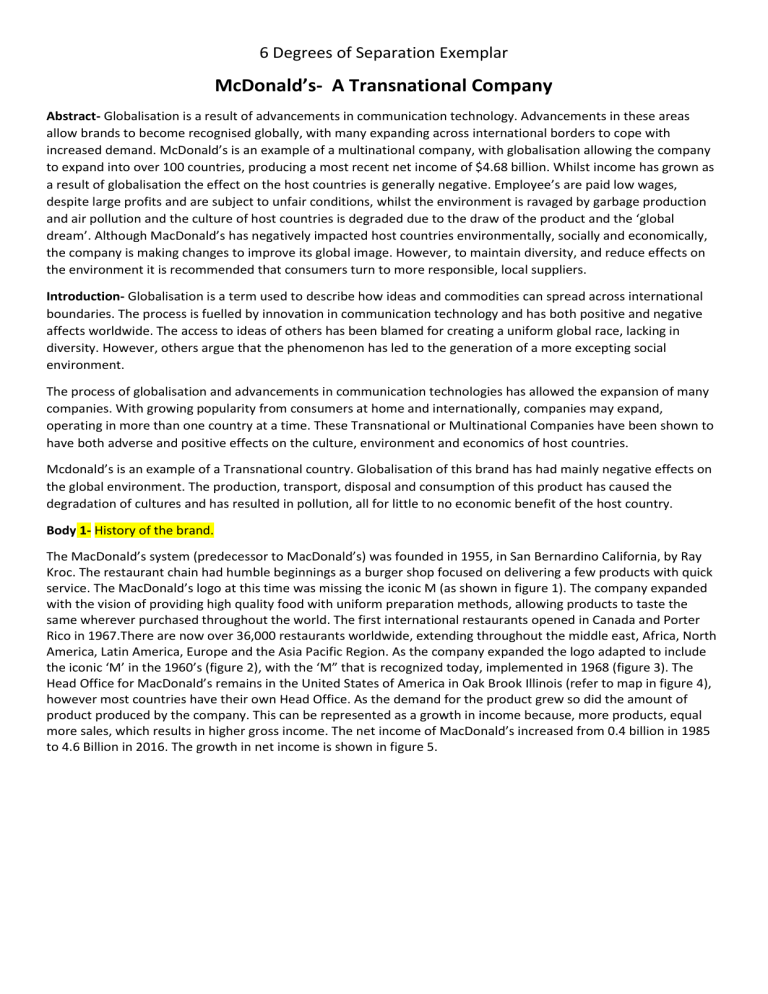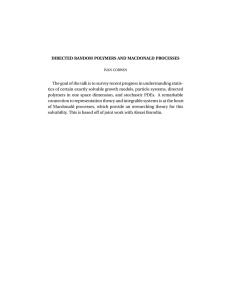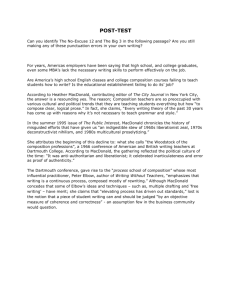
6 Degrees of Separation Exemplar McDonald’s- A Transnational Company Abstract- Globalisation is a result of advancements in communication technology. Advancements in these areas allow brands to become recognised globally, with many expanding across international borders to cope with increased demand. McDonald’s is an example of a multinational company, with globalisation allowing the company to expand into over 100 countries, producing a most recent net income of $4.68 billion. Whilst income has grown as a result of globalisation the effect on the host countries is generally negative. Employee’s are paid low wages, despite large profits and are subject to unfair conditions, whilst the environment is ravaged by garbage production and air pollution and the culture of host countries is degraded due to the draw of the product and the ‘global dream’. Although MacDonald’s has negatively impacted host countries environmentally, socially and economically, the company is making changes to improve its global image. However, to maintain diversity, and reduce effects on the environment it is recommended that consumers turn to more responsible, local suppliers. Introduction- Globalisation is a term used to describe how ideas and commodities can spread across international boundaries. The process is fuelled by innovation in communication technology and has both positive and negative affects worldwide. The access to ideas of others has been blamed for creating a uniform global race, lacking in diversity. However, others argue that the phenomenon has led to the generation of a more excepting social environment. The process of globalisation and advancements in communication technologies has allowed the expansion of many companies. With growing popularity from consumers at home and internationally, companies may expand, operating in more than one country at a time. These Transnational or Multinational Companies have been shown to have both adverse and positive effects on the culture, environment and economics of host countries. Mcdonald’s is an example of a Transnational country. Globalisation of this brand has had mainly negative effects on the global environment. The production, transport, disposal and consumption of this product has caused the degradation of cultures and has resulted in pollution, all for little to no economic benefit of the host country. Body 1- History of the brand. The MacDonald’s system (predecessor to MacDonald’s) was founded in 1955, in San Bernardino California, by Ray Kroc. The restaurant chain had humble beginnings as a burger shop focused on delivering a few products with quick service. The MacDonald’s logo at this time was missing the iconic M (as shown in figure 1). The company expanded with the vision of providing high quality food with uniform preparation methods, allowing products to taste the same wherever purchased throughout the world. The first international restaurants opened in Canada and Porter Rico in 1967.There are now over 36,000 restaurants worldwide, extending throughout the middle east, Africa, North America, Latin America, Europe and the Asia Pacific Region. As the company expanded the logo adapted to include the iconic ‘M’ in the 1960’s (figure 2), with the ‘M” that is recognized today, implemented in 1968 (figure 3). The Head Office for MacDonald’s remains in the United States of America in Oak Brook Illinois (refer to map in figure 4), however most countries have their own Head Office. As the demand for the product grew so did the amount of product produced by the company. This can be represented as a growth in income because, more products, equal more sales, which results in higher gross income. The net income of MacDonald’s increased from 0.4 billion in 1985 to 4.6 Billion in 2016. The growth in net income is shown in figure 5. Figure 1. Original MacDonald’s Logo Figure 2. Logo with the First MacDonald’s ‘M’ Figure 3. The Immergence of the Iconic ‘M’ Figure 4. Map Showing the Number of MacDonald’s Restaurants Worldwide 4,686 4,529 4,757 5,585 5,464 5,5 4,95 4,55 2,4 1,4 0,596 2,6 3,54 4,31 MACDONALD'S NET INCOME 1985 2016 0,433 NET INCOME (BILLIONS OF DOLLARS) Figure 5. 1985 1987 1995 2005 2006 2007 2008 2009 2010 2011 2012 2013 2014 2015 2016 YEAR Body 2- Influence of technology The Globalisation of MacDonald’s can be largely attributed to advancements in technology. Advancements in communication technology have reduced the friction of space allowing products and ideas that were once unavailable, to be available. MacDonald’s is reported to be the brand that invests the most in advertising, spending $963 million on ad campaigns in the US in 2011. Advertisements on television, the internet and sponsorship of televised sporting matches has increased the demand for the product allowing it to grow. Due to this MacDonald’s is now available in more than 100 countries worldwide. Technology has also improved the product itself. Hamburger University is a training facility where individuals are trained and technology is developed. Recently MacDonald’s has incorporated the use of technology into their restaurants in the form of self-service kiosks, mobile ordering and custom burger/ sandwich design. Body 3- Why move overseas Unlike other multinational corporations MacDonald’s expanded across international boundaries in order to access foreign markets, bringing the product to the consumer, rather than to take advantage of poor workers’ rights and low wages. Although the move was not in relation to these issues, Macdonald’s has still come under scrutiny for underpaying their workers, the effects on the environment and the degradation of culture. Body 4- Conflicts The global brand is under pressure to improve working conditions and environmental effects. Workers are reported to be exposed to unsanitary conditions, where they work long, often illegal shifts. The farmers that produce their products are also underpaid. In relation to the environment, MacDonald’s has been coined a great garbage producer of the world. Not only do all the products come packaged in mostly un-recyclable waste, but factories that produce the products pollute the air. Farmlands required to produce the products, clear land, destroying native animal habitats. Eggs used in production are caged rather than free range in order to insure lowest prices. Since 2005, McDonald’s has been using fair trade coffee in some of their restaurants and the brand has committed to obtaining 100% of its coffee from sustainable sources. MacDonald’s is also blamed for degrading the culture in many of its host countries. Here food preparation is important to culture. By offering low cost alternatives people are turning from traditional recipes and their family to the drive through. The draw of transplanted cultural dreams, causes people to leave rural areas (traditionally occupied) in search of the sweat shops and factories of the cities, causing people to leave their traditional home and role. These choices also potentially lead to poor health and nutrition. Conclusion McDonald’s is a transnational country that employs over 350,000 people in over 120 countries worldwide. Access to international markets has allowed the consumer base of the company to increase to over 68 million customers (daily), causing the gross income of the company to grow to 4.6 billion dollars (as of 2016). Although Mcdonald’s employs over 350, 000 individuals many of these receive low wages and are subjected to poor working conditions, with only richer countries profiting to any substantial extent. The availability of this product has also eroded the culture in many countries, causing its people to turn away from their traditional food, roles and homes. The impact of the production, manufacture, transportation and packaging on the environment is substantial. Although Mcdonald’s is putting procedures in place to improve the social, environmental and economic impacts of the brand, it is recommended that people resort to alternate sources of food. Grilled and Zambrero’s are fast food suppliers that use ingredients that are sustainably and responsibly produced (eg. Hormone, preservative free, Free range eggs and meat), that are packaging conscious and that offer the opportunity to improve the social and economic circumstances of those less fortunate. These local brands provide consumers with responsible alternative fast food, that reduce the impact of the global citizen on their local and worldwide community.



